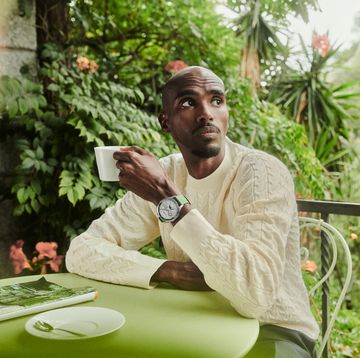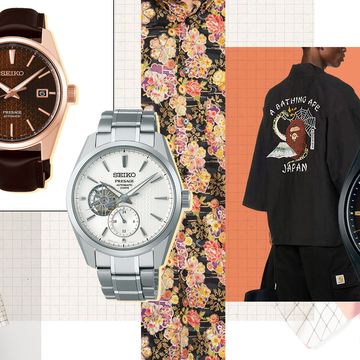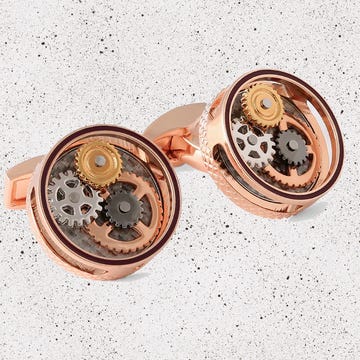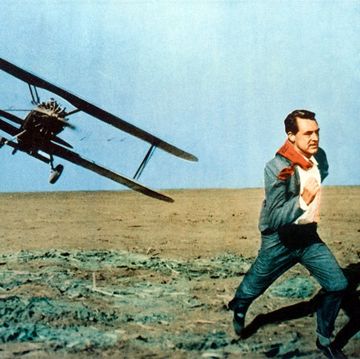In 1968, around the time he was making the first sketches of the dream sports car that he would one day build, John DeLorean gave an interview to Newsweek in which he attacked the conservatism of the US automobile industry. “These rock radio stations, the things they say, what they discuss – that’s what counts,” he said. As the 43-year-old engineer-executive heading General Motors’ Pontiac division, he was inspired by the new youth culture’s emphasis on feeling, and was using records and merchandise to market dreams rather than cars.
He had become infamous for making adverts the way Peter Saville would later make record sleeves: devoid of information concerning, say, price or miles per gallon. His ads were essentially short films based on Jean-Louis Trintignant’s Un Homme et une Femme. Beautiful people driving beautiful cars – that’s what worked now, he told the journalist. In the modern age, there was no need for facts. “Nobody wants to know about that bullshit,” he said. “That’s Detroit talking.”
A GM colleague would tell one of his biographers: “The word genius is overused, but DeLorean was at the top of his profession. He had a sense of what the public wanted, even if it didn’t know what it wanted already. He created style, and that is a precious commodity.” But, the colleague added, DeLorean was “a God-awful administrator”.
That ability to create and style, and the poor admin skills, would produce one of the most notorious, radical and cultish cars ever. It’s a story encompassing Hollywood actors and models, two British governments, a Formula One racing team, Northern Ireland’s Troubles and IRA hunger strikers, a high-profile FBI cocaine-smuggling bust and one of the biggest movie franchises of all time. “Cars, girls and the pitfalls of celebrity culture and the American dream,” says the Super Furry Animals’ singer Gruff Rhys, who, as half of Neon Neon, recorded Stainless Style, a 2008 concept album based on DeLorean’s life.
There have been many cult cars over the years, but none owes quite so much of its status to the story of its creation. The gull-wing doored, V6-engined, stainless steel-panelled DeLorean DMC-12 sports car, manufactured by a rebel US businessman with British taxpayers’ money in Belfast between 1981 and 1983, not only looks good but has arguably the strangest history of any mass-manufactured car.
In 2014, the DeLorean DMC-12 is enjoying a revival of interest, with prices for good-condition cars reaching an all-time high of £20,000-plus (in the mid–late Eighties, they were down to £4,000–£5,000). Christopher Lloyd and the DeLorean time machine recently reprised their Back to the Future roles with a cameo in Seth MacFarlane’s A Million Ways to Die in the West. The Norwegian DJ Todd Terje released the single “Delorean Dynamite”, and in March, Game of Thrones writer George RR Martin excited the geeks (who have loved the car since Back to the Future) by swapping a model dragon egg for a loan of sci-fi writer Ernest Cline’s DMC-12.
The car has become shorthand for a glitzy, high-tech early-Eightiesness.
Meanwhile, in Detroit, old rumours of a Hollywood-produced John DeLorean biopic have reappeared in The Detroit News. A documentary, DeLorean: Living the Dream, is scheduled for release in 2015. In Houston, the DeLorean Motor Company, which since 1995 has rebuilt DMC-12s using the trademark that it bought, is working on the $95,000 electric-powered version of a DeLorean (the DMCev), first announced at the New York Motor Show in 2012. It will do 0–60mph in 4.9 seconds and is expected to retail for north of $100,000. The plan is to have it ready for Back to the Future’s 30th anniversary next year. "It was really inspired when I saw the Tesla Roadster," says Stephen Wynn, DMC’s new CEO, who emigrated from Liverpool to the US in 1980. "We’re not trying to outperform Tesla, we’re trying to do something different."
And in Belfast, where the car has a mythic significance akin to the city’s other globally-famous engineering achievement, RMS Titanic, the crowds still come for a glimpse of the stainless steel or a sit in the low-slung seats. At the Ulster Folk and Transport Museum, the DeLoreans (a production model and a wooden dummy) remain the most popular exhibits, requiring extra barriers to hold back visitors (they can’t touch; fingers leave dark marks on the stainless steel).
The DeLorean DMC-12 with one of its two inital interior choices, in grey
At the headquarters of DeLorean Hire in Aghalee outside Belfast, owner Keith McCracken, a mechanic by trade, fields about 25 enquiries a week from people wanting to hire the cars for social engagements, birthdays or promotions. “It’s mostly people in their twenties and thirties,” he says. “They don’t remember them, but their older relations grew up with it, and they’ve seen it in the film. Multichannel TV means the films are on all the time, so it gets seen more often.”
McCracken credits Back to the Future with enhancing the car’s status. Phil Bell, editor of Classic Cars, agrees, pointing out that the Aston Martin DB5 would not have attained its iconic status without the influence of Goldfinger, either. “The DMC-12 is a piece of motoring folklore and the surviving cars have a cult following of devoted enthusiasts,” Bell says. “Purists deride it as a badly engineered gimmick and commercial failure – they’re certainly nothing like as good to drive as a contemporary Porsche or Lotus – but you only have to observe the spellbinding effect these cars have in public to understand the appeal.”
***
To fully perceive the car’s attraction, you have to understand John Zachary DeLorean’s role as one of the mid-20th century US mavericks who in the post-war period ushered in a new, freer, self-expressive approach to life that competed with the conformity of the industrial era. In the Fifties and early Sixties, US automotive manufacturing was the biggest industry in the biggest economy in the world. General Motors, Chrysler, Ford and the rest employed one-sixth of all working American men, and embodied the national dream of personal mobility and independence. Board members and divisional heads were celebrities, chrome-plated kings in Detroit, political players in Washington, moneyed faces in the media. And DeLorean, son of an irascible, violent Romanian immigrant who worked in Ford’s Detroit factory, rose like a champagne cork through petrol.
Handsome, charming and a brilliant engineer, he invented the muscle car with the ‘64 Pontiac GTO, became GM’s youngest-ever divisional head and, in the Seventies, revitalised the entire Chevrolet brand for General Motors. He wore long sideburns and unbuttoned shirts, dyed his hair and had a chin implant to improve his jawline. He commanded a social circle in California that included Johnny Carson, Engelbert Humperdinck, Sammy Davis Jr and starlets; he married actress/models Kelly Harmon, then Cristina Ferrare. Ruthless in business dealings, he also courted controversy, speaking out in favour of civil rights and – at a time when Detroit was being criticised for lax safety standards, poor build quality and a lack of environmental awareness – championed consumer safety and fuel efficiency.
Even so, he was tipped to be GM’s next president, but in 1973 grew disillusioned and left. He announced he would launch a new, mass-market car brand – the first since Walter Chrysler in 1925 – beginning with a revolutionary, ethically-made sports car.
Inspired by the Sixties’ popularity of basic, economical four-cylinder European sports cars such as the Alfa Romeo Spider, he saw a gap in the market – to manufacture sports cars in smaller numbers and sell them at higher prices, thus reducing the capital investment. This model also was more likely to receive subsidies: it would not be competing with US employers in the same market (apart from Chevrolet’s Corvette, there was no other mass-produced US sports car).
The American public dug the idea and by 1976, DeLorean had raised several million dollars from investors including Carson, Davis Jr, the author Ira Levin and country singer Roy Clark. John Zachary DeLorean lived large – paying himself $125,000 a year – and moved into lavish Manhattan offices where he showed little interest in the nuts and bolts of his plans. He then went looking for the $70–90m he needed from countries seeking to attract businesses in order to cut high unemployment rates. He looked for grants, and talked to Puerto Rico, Spain and the Republic of Ireland. He hustled and played them off each other, but as time passed and new recessions developed, some of those countries began to question the US people’s interest in his rather Sixties-ish dream car. Then, however, he talked to the British government and two rather desperate needs interlocked.
In the late Seventies, economic decline and the Troubles were feeding off each other, turning Northern Ireland into an economic basket case, with Catholic west Belfast particularly badly affected. Roy Mason, the then-Labour government’s secretary of state for Northern Ireland, noting its 50 per cent unemployment figure, described it as “an enclave of the Third World within the UK”. The strategy of Mason and the Northern Ireland Development Agency (NIDA) was to stem IRA recruitment by bringing “jobs, homes and hope” to the region. DeLorean, promising to create 2,500 jobs and a prestige company that would attract others inside 18 months, was irresistible. Although the government’s own consultant’s report was sceptical, NIDA took only 45 days to agree to give DeLorean around £54m in grants and loans – the vast bulk of what he required to build his Belfast operation and fund the company – with very little control over the project. DeLorean flew in to sign the deal in front of international news reporters in 1978, and then announced he was going house hunting. He wanted to buy a castle.
The story, of course, ended in an international scandal, but those who worked at the factory are still loyal to the memory of its founder. Neal Barclay joined the DeLorean shipping department in March 1981, when he was in his early twenties. His job was to park DMC-12s for the transporters to load and ferry them to the docks. His house in north Belfast remains a shrine to the company: images of the car, shelves of books, boxes of cuttings and letters and, above the fireplace, a large picture of the car he rescued from a skip after some company offices were firebombed the night hunger-striker Bobby Sands died. “It was the best job I ever had,” Barclay says.
“It was the atmosphere – everyone was caught up in the car and its story. It was in the media all the time, so you followed it all; we were part of this story about this glamorous, wealthy guy who looked like a Hollywood star.”
To Barclay, not aligned politically or religiously, it seemed the factory would be the first part of a decent future for a city with a proud engineering history. “I’d go out collecting materials from local suppliers, so you could see the benefit – John DeLorean gave us hope.” He shows me photo after photo and videos from those days of hope. It is noticeable that most of the people in them are smiling. “I had a dream job, no mistake,” he says. “But then it turned into a nightmare.”
The original DMC-12 (named, some claim, because it was intended to retail for $12,000) was to be made from fibreglass with stainless steel panels, making it lighter (and thus more fuel-efficient), safer and rust-free. It would have distinctive gull-wing doors (DeLorean was very taken with the Fifties’ Mercedes 300SL) and a rear-mounted engine. The point was to be new: DeLorean felt Detroit had been selling customers the same car with cosmetic changes for 20 years. He drew some sketches himself, but commissioned the styling from Giorgetto Giugiaro’s legendary Italdesign company, famous for its work with the finest European automobile brands. By the time it came to build the car, the designs proved dated and manufacturing issues necessitated changes, so DeLorean partnered with Colin Chapman’s Lotus. Then the dominant force in F1, it re-engineered the car at its base outside Norwich (critics later noted its more-than-passing resemblance to the Lotus Esprit).
The 72-acre factory complex was built in record time between Republican and Loyalist areas in Dunmurry, south of Belfast. Driving there from the airport, visitors passed checkpoints, burned-out buildings and painted kerbstones. The managers were mostly young, the receptionist a former beauty queen, the marketing slogan “To live the dream”; 800 applied for jobs, attracted by good wages and working conditions. Sectarian symbols were banned, and tension notably absent. “Everyone was for DeLorean,” says Mark Kennedy, curator at the Ulster Folk and Transport Museum. “You could never get a consensus on anything here, but everyone believed this would be a good thing.”
The beginning was rocky: deadlines were missed, DeLorean wanted more government money and the first cars were so poor they had to be reworked in the US. By the end of 1981, though, orders were good and the factory was humming despite its largely inexperienced workforce. Subsequent stories tended to obscure the fact that for a while DeLorean constituted – as highly-experienced former executive Nick Sutton wrote in his book The DeLorean Story – “a little miracle”.
There were problems in the summer of 1981: the hunger strikers were dying. Bobby Sands was from the Catholic Twinbrook estate next to the factory, and Sutton remembers firebombs, staff working around British soldiers trying to protect the complex, and men stopping work in the body shop to commemorate the dead. But the factory was not heavily targeted as has been claimed and the company was to an extent co-opted: at Sands’ funeral, some men among the 100,000 there held a banner saying “DeLorean Nationalist Workers” and showing a DMC-12 smashing through an H, signifying the H-Blocks at Maze prison.
The real difficulties began with ongoing recession and the extreme winter of 1982 (automobile lore says people do not buy cars when there is snow on the ground) and intensified when John DeLorean tried to boost his planned flotation of the company by doubling production to 80 cars a week. The target was unreachable, and as extra materials had to be ordered, the company ran out of money, a process speeded up by the owner’s largesse and ludicrously high-spending operation in the US (it was alleged, incorrectly, that DeLorean had solid gold taps in his bathroom). The first profligacy scandal broke in the autumn as he was asking Britain for yet more money. Whispers about corruption and DeLorean’s links to the criminal world never ceased.
The company went into receivership in February 1982, and in October, John DeLorean was entrapped by the FBI in a Los Angeles motel room as he took part in a huge deal to buy $24m of cocaine. He had been trying to raise money to save the business; at one point he looked into a briefcase full of cocaine and remarked it was “better than gold”. Although later acquitted, his character was tarnished – but there was more to come. It was soon uncovered that he and Colin Chapman had embezzled around £10m of investment money intended for the business. At one of several subsequent US trials for fraud and negligence, his now ex-wife Cristina said that while they were married, she had watched him forging signatures, handling documents with rubber gloves and steaming open envelopes. He avoided jail, but would never be a serious player in business again. He died of a stroke in 2005, aged 80 (his tomb at Michigan’s White Chapel Memorial Cemetery depicts a DMC-12, with its gull-wing doors open).
There remains a persistent rumour in Belfast that the FBI plot was ordered by then-president Ronald Reagan as a favour to Margaret Thatcher. The argument runs that she wanted to avoid criticism for not funding DeLorean further while continuing to pump money into other local businesses that employed mainly Loyalist labour.
Whatever the explanation, the factory finally closed in early 1983; 9,000 DMC-12s had been produced, of which some 6,000 are estimated to still be in running order. Three gold-plated cars exist; part of a planned 100 that American Express aimed to sell for $85,000 each to its gold card holders. Inside one of these vehicles, a member of staff had secretly written lines from the King James Version of the New Testament: “Your gold and silver is cankered; and the rest of them shall be a witness against you, and shall eat your flesh as it were fire. Ye have heaped treasure together for the last days.” In the last crate of the last shipment, workers placed a small coffin with a dummy of John DeLorean dressed in factory overalls and a photo of his face cut out from a magazine.
The resurrection, of the car if not the man, began in 1985, and originated with director Robert Zemeckis’ anxiety about a refrigerator. Zemeckis and his writing partner Bob Gale had some years earlier finished a script about a teenager and his eccentric inventor friend travelling through time in a fridge, but every studio in Hollywood had passed. Opinions changed in 1984 after Zemeckis had a hit directing Romancing the Stone, an adventure caper in the Raiders of the Lost Ark mould. Fine-tuning the script, Zemeckis worried that kids might copy the movie and become stuck inside fridges. A car seemed a good alternative and the DeLorean DMC-12 was chosen to boost a gag in the script. “When Marty [McFly] arrived in 1955,” Zemeckis explains in Back to the Future: The Official Book of the Complete Movie Trilogy, “we wanted the family to mistake the time machine for a flying saucer. We searched for the appropriate vehicle and found that the DeLorean’s gull-wing doors and design give it the resemblance of a spaceship.”
Keith McCracken says it is, above all, the flying car – seen briefly at the end of the first Back to the Future, and at length in the sequels – that people remember (“that and the flashing lights inside”). To achieve that, Zemeckis had a lightweight, full-sized car built and flown on wires, with George Lucas’s Industrial Light and Magic studios supplying shots with one-fifth-sized models complete with puppet Martys and Doc Browns. Flying cars and all, the trilogy has become one of the most profitable franchises of all time, and the DeLorean symbolised for Eighties and Nineties’ kids what Bond’s Aston Martin DB5 had for their parents. There is now a mini-automotive subculture of conversions with most DeLorean “time machine” parts available online.
McCracken has converted three cars, one from each film (“Google it, ‘Flux Capacitor’ or whatever, you’ll find it”) and keeps another pristine model for himself. When he takes me out in it, I notice three things: the first is how bright the stainless steel shines, the second is how loud it is (even for a sports car), and the third is you have to be careful how you close the doors, which can stick. It is hard to shake the idea of it being a UFO. People at DeLorean conventions claim the police at checkpoints in Northern Ireland had similar feelings when, in the early Eighties, the engineers would illicitly take models out at night to test them, safe in the knowledge that the cars were fast enough not to be caught. These stories may or may not be true, but then when you’re talking about the DMC-12, you get to a point where facts and figures are not the most important thing. That’s Detroit talking, after all.
***
On a cold spring afternoon in north Belfast, Neal Barclay shows me his collection of clips on DVD and video. One has him speaking at a DeLorean convention in Gettsyburg, Pennsylvania, a few years ago. He is a tentative but compelling speaker; his love for the subject winning through his nerves. I have heard about the speech from other enthusiasts: Neal’s emotion was such, they say, that after he spoke people crowded around him for hours, leaving the actors who had appeared in the Back to the Future movies somewhat neglected.
Neal presses play and the footage rolls: “I call DeLorean Motor Cars Limited Belfast’s other Titanic,” he tells the crowd. “John was the captain of the ship. We the workers were the crew. The investors – the Labour government, the dealers and others – were the paying passengers… We were on a collision course, heading straight for the iceberg – Thatcher’s government. The ship sank, but a few years later it was time to raise it, in a film called Back to the Future. Christopher Lloyd and Michael J Fox were great, so were all the other actors, actresses and everyone involved in the making of the film, but the DMC-12 was the real star for me.” He gulps and pauses, fighting back tears. “The film made me proud… It confirmed that the car was not a failure.”
History. After the factory closed, Neal Barclay was unemployed for two years. He hoped for another driving job, which he found driving road sweepers for the council, and has done so ever since. It’s decent money, he says, because he does the city centre, which is regular work.
In the front room, under that image of a DeLorean DMC-12 he retrieved from a factoryskip 30 years ago, Neal looks at me. “Sorry,” he says. “I’m a bit emotional there.”
I say everybody gets emotional about this car.
“We were caught up in something. It was about more than a car, you know… we were living the dream. We were living in John DeLorean’s dream.”
This article was first printed in Issue 4 of Esquire's Big Black Book. On newsstands now.
***
MORE BIG BLACK BOOK:
The Cult Of The Leica Camera
Winter Style From Whistler Mountain
How Bollinger Wooed The British
***









